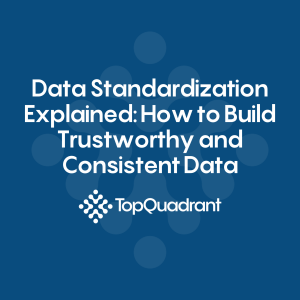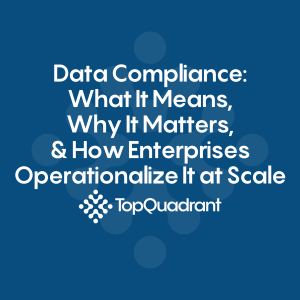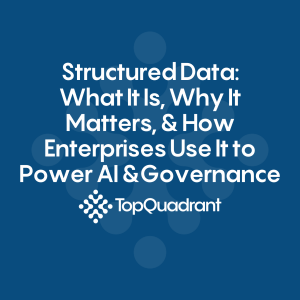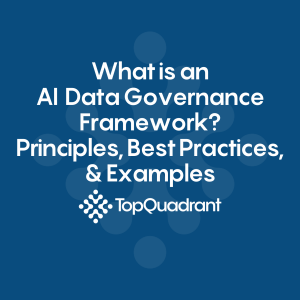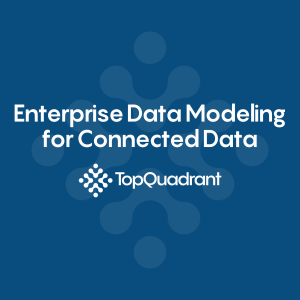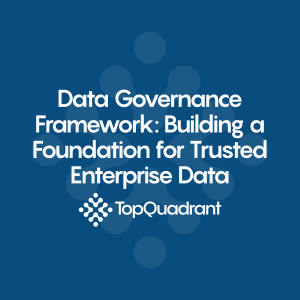Q&A part 2 from the webinar: “What’s New in TopBraid EDG 7.1?”
We received many questions during our recent webinar What’s New in TopBraid 7.1? Follow the webinar link to see the recording and the presentation slides. Because there were many questions, we decided to organize them into categories and to publish answers in two blogs.
In the part 1 Q&A blog, we answered questions about the new EDG Diagram Panel, changes to other panels and changes to the built-in EDG models. In this part 2 blog you will see answers to questions about the new integration capabilities of TopBraid EDG, about TopBraid EDG Studio and TopBraid Composer as well as about upgrading to 7.1 and future product directions.
Questions about New Integration Capabilities
1. How do we use terms in ontology for SharePoint?
Integration with SharePoint as available in 7.1 is with taxonomies in EDG. The underlying model of the SharePoint Term Store is much better aligned with SKOS taxonomies. By the underlying model we mean the concepts of term sets, term groups as well as different properties for terms. These design concepts work nicely with SKOS taxonomies, allowing for a smooth mapping and two-way synchronization.
Ontologies, on the other hand, have a bigger mismatch with the Term Store since the goal of classes in ontologies is to describe sets of resources based on their property values as opposed to simply define a hierarchy of tag terms.
If your ontology is not a model of a domain with class and shape definitions, but rather a taxonomy of commonly used terms with verbal definitions, we recommend transforming it to a taxonomy in EDG. If you have questions on how to best accomplish this, follow up with TQ support.
2. Are you basically saying the entire ecosystem of Node.js is now available to EDG?
Yes, that’s exactly what Holger described. Node.js is very popular as a back-end JavaScript runtime environment that executes JavaScript code outside a web browser. It lets developers use JavaScript for server-side scripting and to write command line tools. Node.js represents a “JavaScript everywhere” paradigm, unifying web-application development around a single programming language. Starting with the 7.1 release you can create a Node.js application that makes use of any Node.js APIs and libraries and, within it, access and integrate with the TopBraid EDG capabilities.
What we offer is basically an ADS API (ADS stands for Active Data Shapes) as your interface to TopBraid EDG. This provides all the features that you need to talk to the asset collections (RDF graphs) in EDG, to make queries, execute functions, make updates and so on. ADS is an innovative way for developers to interact with the knowledge graphs in EDG in a declarative manner. Internally, ADS generates a JavaScript API based on the system and user-defined SHACL shapes and associated scripts. For an introduction to ADS, see this blog https://www.topquadrant.com/configuring-topbraid-edg-with-javascript/.
In the 7.1 release, ADS APIs can be used not only internally in EDG (using the scripting functionality EDG provides), but also in React components and in external Node.js applications – as shown in the below architecture diagram.
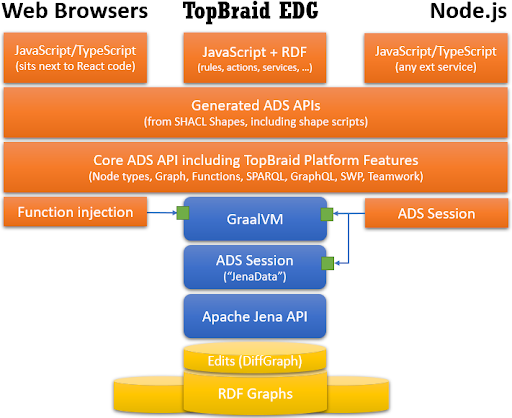
For documentation on how to use ADS from your Node.js applications, see https://datashapes.org/active/nodejs.html.
Questions about TopBraid EDG Studio and TopBraid Composer
3. What features of TBC are missing from EDG Studio?
We’ve tried to make EDG Studio as complete as possible so that people are not missing any TBC features. WIth this, all the features that used to be only in TBC, like SPIN and SWP editing, are now also available in EDG. We hope that, for at least all the EDG customization work and any other typical activities, EDG Studio is completely sufficient. Overall, we would say there is not much missing, with the exception of some esoteric features. Further, keep in mind that EDG itself is a much more modern tool. For example, it has much better, more user friendly support for SHACL than what is available in TBC.
People get used to a certain way of working. For a long time TBC users moving to EDG Studio represents a change. EDG Studio is not and will never be 100% the same as TBC. Having said this, we believe that for users migrating from TBC, EDG Studio will deliver advantages that outweigh any inconvenience that may come with the change. To make the migration as smooth as possible, we are working on providing necessary resources, including documentation and videos. And, of course, we are looking for your beta feedback.
4. Is it possible to edit already used customizations with EDG Studio?
Yes. If you have created customizations in SWP, you can edit SWP using EDG Studio.
5. What will be the difference between TBC Free and TBC ME now that the EDG part is removed from TBC ME?
Access to the localhost version of EDG was never the only difference between TBC Free and TBC ME. TBC Free has a very limited number of views and never offered many of the features available in the full version of TBC. For example, imports from other data sources, UML and Graph diagrams, etc.
Questions about upgradability and future directions
6. Will existing customizations continue to work in 7.1?
Yes. We have not deactivated anything. At least, nothing significant. There are minor changes with each release and they are recorded in the migration notes.
Any SWP and SPIN features that you have used in the past should still work. However, our customization approach has shifted away a little in the direction of using JavaScript. We find that users are more accustomed to this approach and, to respond to this, we are now focusing more and more on JavaScript for the extensions and customizations. We’ve added a number of extension points based on ADS.
7. What will be the future of Topbraid Composer? Are you planning to retire TBC?
For users that are not using or planning to use TopBraid EDG, nothing changes with the 7.1 release. They can continue to use TopBraid Composer as usual. TopBraid Composer has been quite stable for a number of years now as our new feature development has focused on TopBraid EDG. This continues to be the case. The main difference is that in TBC 7.1 users will no longer be able to launch TopBraid EDG from TBC. The ability to launch EDG was always there to support EDG customizations for EDG customers and/or local evaluation of EDG for prospects. These goals are now supported by the TopBraid EDG Studio.
TopBraid EDG users should move from TBC to the EDG Studio. It has the same UI and capabilities as EDG on the server. For the 7.1 release, many features were added to close the gap between the model and script development capabilities available in TBC and EDG. For example, we have added to EDG support for working with SPIN and SWP, integration with Git, etc.
Starting with the 7.1 release, EDG Studio is the tool to use locally for EDG customizations e.g., development and testing of models, rules and server-side scripts. This work could also be done in the EDG server itself i.e., on the development (as opposed to the production) node, but many users want to have these capabilities locally. All EDG users will be given an EDG Studio license for each license of TBC their organization owns. During the beta period we are doing this on request. After the 7.1 release, we will mail new licenses to all EDG customers. With this, EDG customers will be able to use both the TBC licenses they previously received and the new EDG Studio licenses.
If you are not a current user of TopBraid EDG and would like to evaluate it, contact us using https://www.topquadrant.com/products/topbraid-enterprise-data-governance/request-edg-evaluation-account/. We can set up a free evaluation server or, if you prefer to test locally, send you a free term license of TopBraid EDG Studio.
8. What is the status of the SHACL standard update? What is the direction the standard will go?
This is a question for the broader SHACL community. TopQuadrant is a strong supporter of SHACL. We are very pleased to see its continuously growing adoption. We led the W3C Working Group for the initial release of SHACL, created a reference implementation and are leveraging SHACL heavily in TopBraid EDG. During the last 3-4 years, we have been building extensions to SHACL inspired by the feedback from our customers, and publishing this work in the https://datashapes.org/site. We believe this work is useful and important and will continue to move forward with it.
However, this does not mean that all of our extensions must become a part of an officially ratified standard. Standards are always consensus driven. Other implementers and users may have a different opinion on what should or should not be added to the standard. Also worth mentioning is that a key aspect of SHACL is a built-in extension mechanism. In other words, there is already a standards-based approach for adding custom constraint components and plugins for different language implementations.
Very recently, one of the community members created a public Discord server. This was done with a desire to increase community engagement around SHACL. And a belief that a new communications platform dedicated to SHACL topics is needed because not all modes of communication and engagement fit in the mailing list or Github issues threads.
One of the channel’s topics already active on the discussion platform is that of SHACL 1.1. The goal of the channel is to gather requirements, input and feedback. By participating, you have a chance to shape what the next version of SHACL will look like.
The public invite link is here: https://discord.gg/RTbGfJqdKB
-
Data Governance69
-
Vocabulary Management9
-
Knowledge Graphs44
-
Ontologies15
-
Data Fabric8
-
Metadata Management21
-
Business Glossaries6
-
Semantic Layer12
-
Reference Data Management7
-
Uncategorized2
-
Data Catalogs16
-
Datasets11
-
Taxonomies4
-
News5
-
Policy and Compliance6
-
Life Sciences6
-
Automated Operations6
-
Financial Services10
-
AI Readiness25
-
Podcasts1
